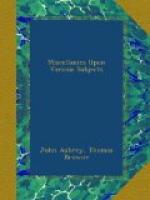It is a sarcasm, more malicious than true, commonly thrown at the church-men, that they had too much land; for their constitution being in truth considered, they were rather administrators of those great revenues to pious and publick uses, than usufructuaries. As for themselves, they had only their habit and competent diet, every order according to their prescribed rule; from which they were not to vary. Then for their tenants, their leases were almost as good to them as fee simple, and perchance might longer last in their families. Sir William Button (the father) hath often told me, that Alton farm had been held by his ancestors from the Abbey of Winchester, about four hundred years. The powers of Stanton Quintin held that farm of the Abbey of Cirencester in lease 300 years: and my ancestors, the Danvers, held West Tokenham for many generations, of the Abbey of Broadstock, where one of them was a prior. Memorandum, that in the abbies were several corrodies granted for poor old shiftless men, which Fitzherbert speaks of amongst his writs. In France, to every parish church is more than one priest, (because of the several masses to be said) which fashion, Mr. Dugdale tells me, was used here, and at some churches in London, in near half a dozen.
In many chancels are to be seen three seats with niches in the wall (most commonly on the south side) rising by degrees, and sometimes only three seats, the first being for the bishop, the second for the priest, and the third for the deacon. Anciently the bishops visited their churches in person. This I had from Mr. Dugdale; as also that in many churches where stalls are, as at cathedrals, (which I mistook for chauntries) and in collegiate churches. This searching after antiquities is a wearisome task. I wish I had gone through all the church-monuments. The Records at London I can search gratis. Though of all studies, I take the least delight in this, yet methinks I am carried on with a kind of oestrum; for nobody else hereabout hardly cares for it, but rather makes a scorn of it. But methinks it shows a kind of gratitude and good nature, to revive the memories and memorials of the pious and charitable benefactors long since dead and gone.
Eston Pierse, April 28, 1670.
Horoscope of John Aubrey’s nativity, from his own Sketch.



